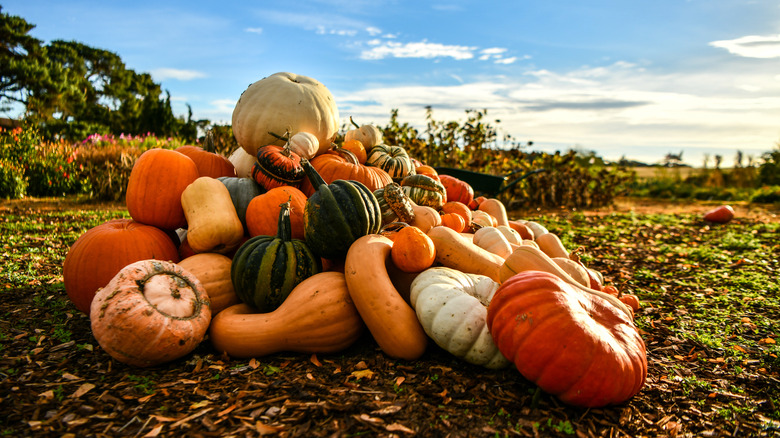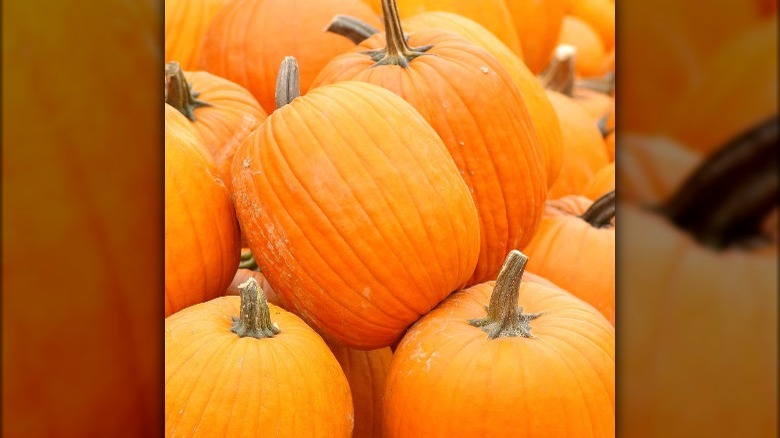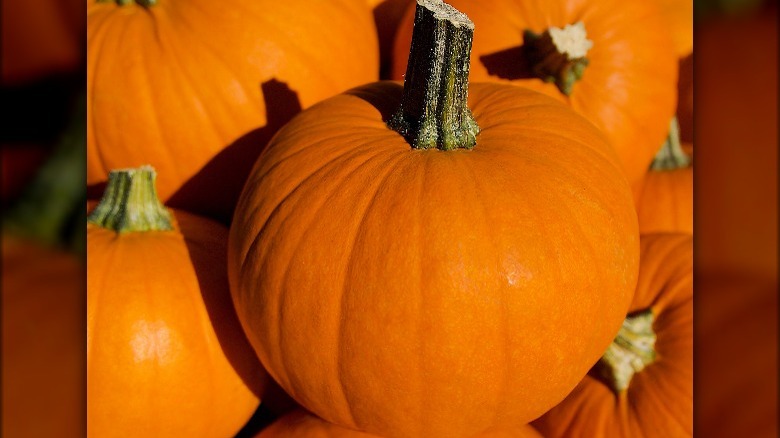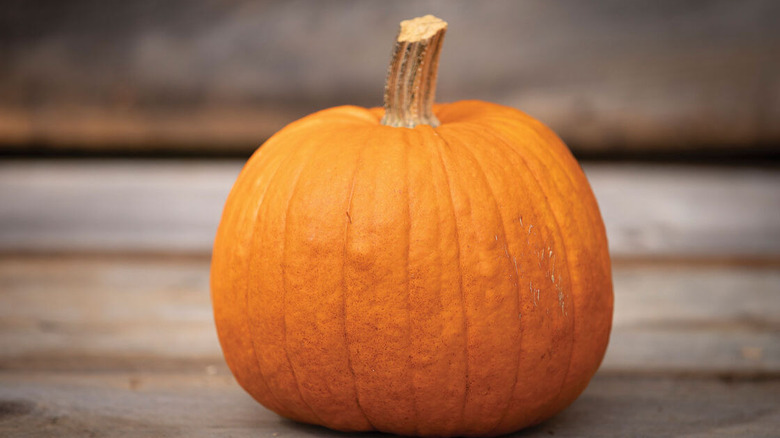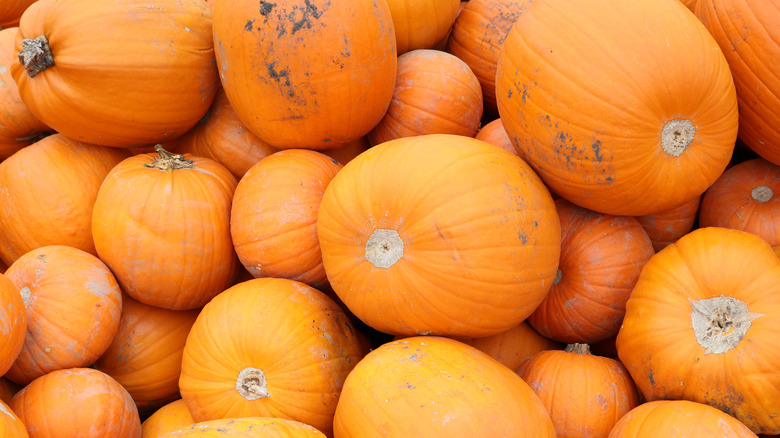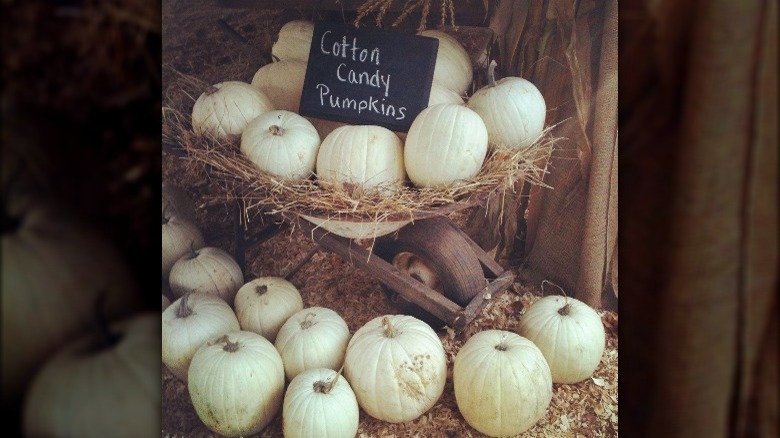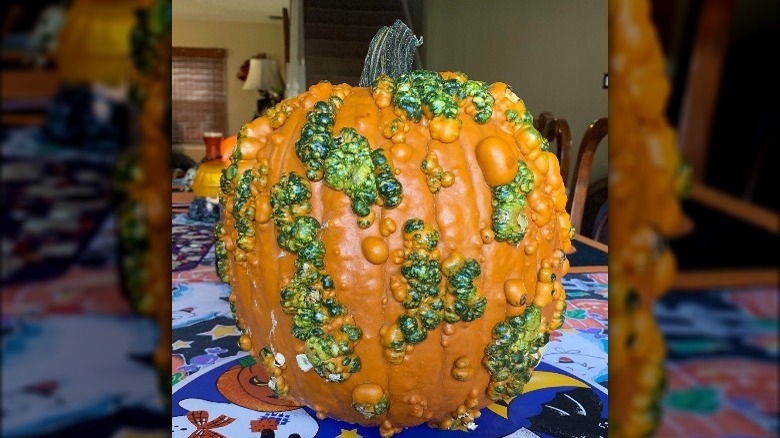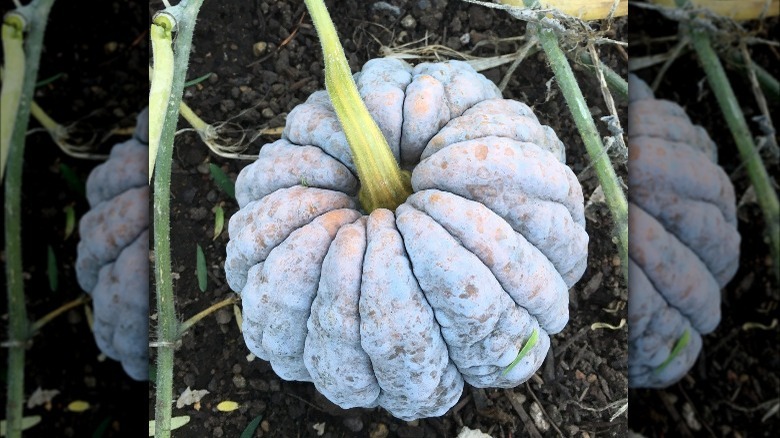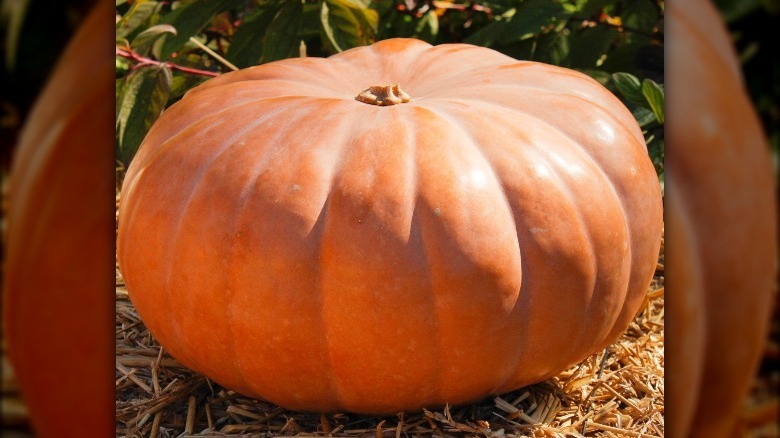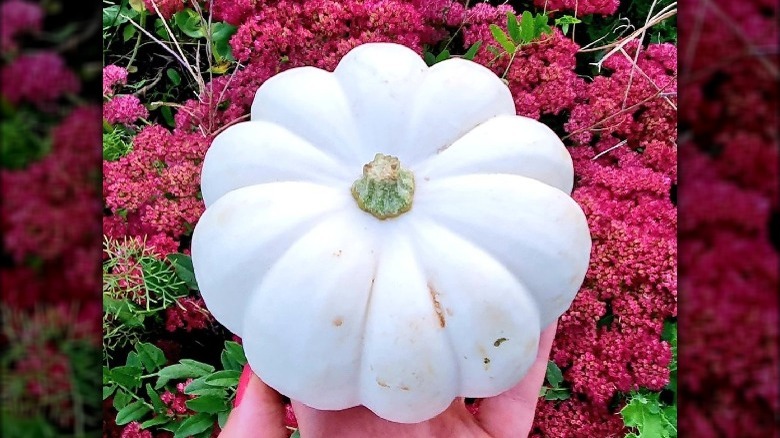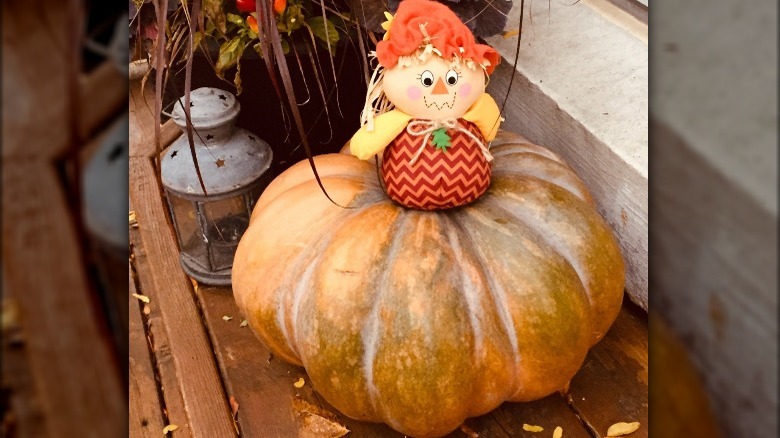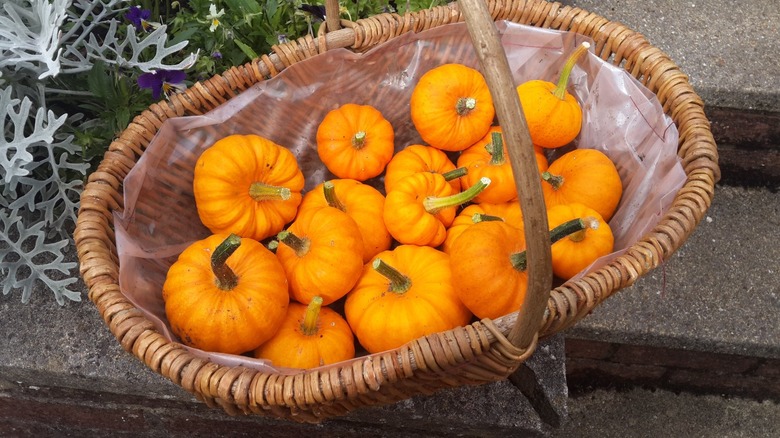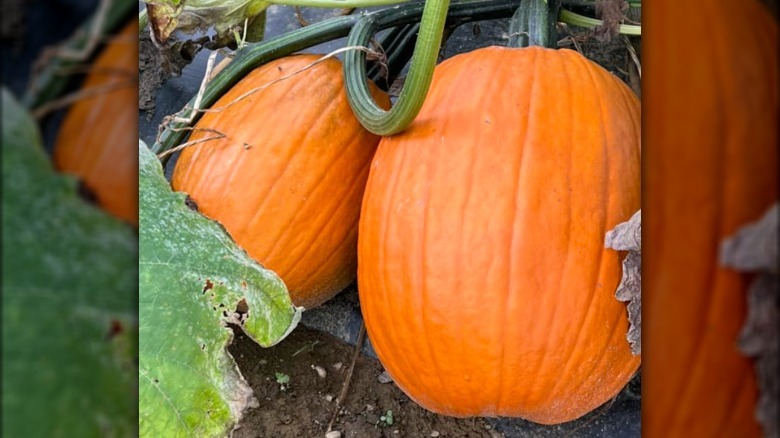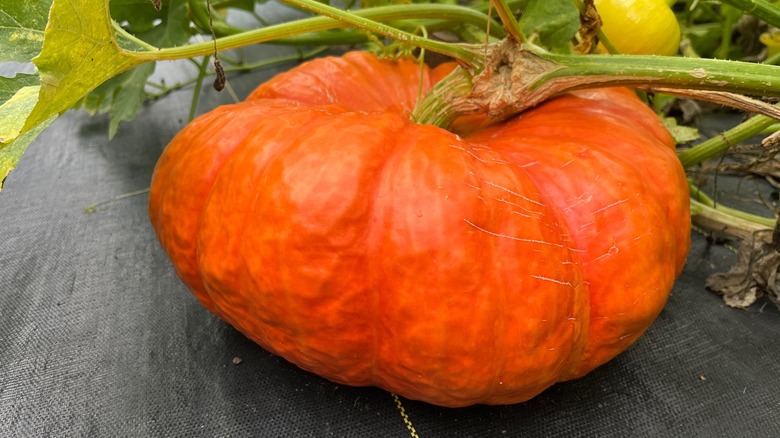13 Types Of Pumpkins Perfect For Mastering The Fall Aesthetic
Whether you love fall for the cooler temperatures or the influx of Starbucks pumpkin spice lattes, there is no denying that the season has a certain aesthetic to it that no other time of the year can quite match. Among the ubiquitous features, pumpkins are a universal symbol of autumn, signaling the end of summer.
Not all pumpkins are created equal, however. In fact, according to Clean Air Gardening, there are approximately 250 different types of pumpkins, though that number fluctuates depending on how you break down the varieties. They come in different shapes, sizes, and colors, with some best suited for decor and others to use in your favorite pumpkin recipes.
If you are looking for that picture-perfect autumnal variety of winter squash to capture an idyllic fall mood (or even to use in your grandma's pumpkin pie recipe), we have a rundown of the top 13 pumpkins to consider adding to your front doorstep.
1. Autumn Gold
For many people, the Autumn Gold variety is likely what comes to mind when thinking of pumpkins. Though the gourds come in a number of different colors, they are most commonly found in bright orange. Autumn Golds come in a small to medium size, and according to Nanas Bloomers, they can be harvested earlier than many of their counterparts since they turn that iconic golden-orange color well before the majority of other pumpkins.
Looking for the perfect pumpkin to use in your pie recipes this fall? Not only is the Autumn Gold a beautiful color to display, but it fulfills a number of different culinary duties as well. The versatile pumpkin can be used for cooking and baking pies, and its seeds are ideal for roasting. And, because they can usually be harvested before other pumpkins, you can get an early head start on those pies if you just cannot wait to fully embrace all things autumn.
2. Baby Pam
As the name implies, this variety of pumpkin we recommend you seek out at your local market comes in on the smaller end of the scale. But, as they say, good things often come in small packages. Baby Pam pumpkins are itty-bitty and almost look like a miniature version of the Autumn Gold. Seedway describes Baby Pam pumpkins as being brightly colored and smooth with sturdy stems.
When it comes to cooking, the usefulness of Baby Pam pumpkins is a topic of debate depending on the source. While Seedway notes that they are better used for decoration (their small size also makes them easier to paint), Harvest to Table notes that they are a good choice for baking pies. You should be able to find multiple ways to use Baby Pam pumpkins, such as collecting them for fall decorations before slicing them open near the end of the season to use in the kitchen.
3. New England Pie
The fall season is often associated with the Northeastern region of the United States, specifically New England. The image of watching the falling leaves while sipping on apple cider is practically synonymous with autumn time in the area. It should come as no surprise that there is a pumpkin variety named after the region.
The New England Pie, also known as the New England Sugar Pie, is a smaller type of pumpkin with a recognizable vibrant orange hue. Perfect for your fall setup, these cute pumpkins are a multipurpose option to bring home. The origin of its name is believed to have come from the fact that pumpkin pies were an early staple of New England dining, thanks to England's deeply rooted pie culture (via History.com).
This variety of pumpkins did not get its name as only a tribute. According to Rare Seeds, this pumpkin is sweet, smooth, and perfect for your pumpkin pie recipes. Many gardeners note how easily the seeds grow, so perhaps you'll want to include a few New England Pies in your garden in time for next fall.
4. Ghost Rider
This pumpkin certainly has a fitting name for the eerie Halloween season that coincides with all things fall. Ghost Rider pumpkins may sound spooky, evoking images of the Headless Horseman riding through the forest with his severed pumpkin head (via History Channel). But in reality, their appearance can be easily mistaken for other kinds of pumpkins. That's because they look like so many: round and orange.
According to The Royal Horticultural Society (RHS), the Ghost Rider's round uniform shape makes for easy carving if you're looking to add a few jack-o'-lanterns to your front porch this fall. Shoot Gardening echoes this opinion, confirming that they are great for carving. So, as you go out in the world in search of that perfect pumpkin to turn your home into a Halloween-themed oasis, be on the lookout for Ghost Riders to carve ... and perhaps pick up a different variety for cooking.
5. Cotton Candy
Whereas the Ghost Rider sounds like a character out of a horror film, the Cotton Candy pumpkin brings to mind fairytales, candy shops, or a children's cartoon. This is the first pumpkin on our list that comes in a color distinct from the typical orange hue we have seen so far. Don't expect to find a bright pink or blue pumpkin here, but Cotton Candy pumpkins do stay true to their name. They look like small spheres of cotton candy, with a milky-white exterior and interior, according to Kitchen Garden Seeds.
The white color provides the perfect blank canvas for painting, or you can use its unique appearance as a decoration without any added color whatsoever. This pumpkin might work in a culinary setting but it's probably best just used as decoration. Rupp Seeds concurs and doesn't recommend cooking or eating them. However, taste is subjective and Kitchen Garden Seeds describes the flesh as very sweet (much like cotton candy) and pleasant to eat so you may want to test it out.
6. Warty Goblin F1 Hybrid
If there was a contest for a pumpkin that could summarize Halloween in an instant, the Warty Goblin F1 Hybrid would win the blue ribbon. Much like an old witch with warts (or a zombie apocalypse, per Kitchen Garden Seeds), the Warty Goblin is a pumpkin with a face that only its mother could love. While the pumpkin comes in a typical round shape and orange color, dark green warts all over its surface distinguish it from the usual suspects.
If you want a front porch display this fall that will serve as an easy conversation starter, decorate to your heart's content with Warty Goblins. Harris Seeds points out that the warts maintain their green color for weeks after the pumpkin is harvested, so you should make it through most of the season before they fade away. And while any pumpkin could be considered edible, you may want to leave this particular kind on your doorstep and seek out other varieties for cooking and baking.
7. Black Futsu
The Warty Goblin could only be given a run for its money by the Black Futsu, another unique pumpkin that will work wonders in your fall decorations. The Black Futsu squash comes in less of a traditional round shape and is more square. Its defining feature is its rather bumpy skin, which Specialty Produce notes may display warts. The color of the Black Futsu changes as it matures, going from very dark green to a paler, almost cloud-like orange over the course of its growth.
Don't run to your local market expecting to find Black Futsu pumpkins in good supply though. According to Specialty Produce, these are a rare variety of pumpkins in North America and are more commonly found in Asia. In fact, Johnny Seeds notes that the Black Futsu is considered a culinary specialty in Japan. Once you get your hands on one, it makes for a great ingredient in many dishes, both in its raw and cooked form. The warm and nutty flavor is similar to roasted chestnuts, another fall favorite.
8. Long Island Cheese
No, this curiously named pumpkin does not taste like cheese. Rather, the Long Island Cheese gets its name from its appearance, which Southern Living describes as similar to a wheel of cheese. A standard Long Island Cheese is typically wide and flat, just like your favorite wheel of cheddar or Parmigiano. Its slightly cloudy color also lends itself to its unique cheesy resemblance. If you choose to display these pumpkins out of the kitchen and intact, their quirky look will make a good addition to your decor. Scatter these around your front yard — perhaps with some mice to complete the look.
Appearance aside, the Long Island Cheese is a great option for cooking. Southern Living notes that it is a solid choice for your fall recipes, and Our Harvest also points out that the seeds are delicious when roasted in the oven. Long Island Cheese pumpkins have been around for awhile, giving squash enthusiasts plenty of time to come up with new and inventive ways to use this particular variety.
9. Baby Boo
The Baby Boo reigns supreme in the category of cutest pumpkins. Just as its name implies, Baby Boos are small (like babies) and white (like ghosts). If Casper the Friendly Ghost were a pumpkin, he would likely be a Baby Boo. According to Territorial Seed Company, Baby Boos can fit in the palm of your hand, making for adorable photo ops all season long. The white color also creates an interesting contrast with any orange pumpkins you might pick up along the way.
Cuteness aside, Baby Boo pumpkins are also great for cooking. Territorial Seed Company notes that they are absolutely edible, so don't let the white color dissuade you. However, whether you want to use Baby Boo pumpkins for decor or for eating, you will want to harvest them before they reach full maturity to take advantage of their distinct bone-white hue. According to The Columbus Dispatch, a fully mature Baby Boo is no longer white and turns pale yellow.
10. Fairytale
The Long Island Cheese isn't the only pumpkin variety that kind of looks like a wheel of cheese. According to Urban Farmer, that is one of the defining characteristics of the Fairytale pumpkin, though its name does not immediately give itself away. This variety is also oblong and quite flat in shape. Compared with the Long Island Cheese, Fairytale pumpkins tend to have more pronounced ribs on their surface. These qualities set it apart from any old supermarket pumpkin you might grab for your autumn decor.
As for baking, Urban Farmer claims that you cannot go wrong with a Fairytale pumpkin. So, get all of your pumpkin pie and pumpkin bread recipes ready and pick up one of these fantastical orange varieties. Hoss Tools also describes Fairytale pumpkins as an ideal ingredient for your fall recipes like pumpkin soup, since they have a high proportion of flesh (okay, now we're getting hungry).
11. Jack Be Little
Jack be little, Jack be quick, Jack jump over the ... pumpkin patch? In the grand scheme of the history of pumpkins (which dates back to Central America around 5,500 B.C. according to History.com), Jack Be Little is a relative newcomer, first making its appearance in 1989 according to Minneopa Orchards. In its short lifespan, this cute pumpkin has quickly won over the hearts of fall enthusiasts, making it a common option you might come across at your local supermarket.
Its small size means it's easy to buy in bulk to include in a wide variety of decorative setups around your home. In fact, the Jack Be Little can last quite a long time — up to a year if taken care of properly. That way, your fall decorations will last well into the months that follow if you are desperately clinging to the remaining fragments of your favorite season.
If you prefer to use them in your recipes, you will find that they work in both savory and sweet dishes, according to Minneopa Orchards. Due to their miniature format, however, you may need several Jack Be Little pumpkins for one recipe. Perhaps that's one reason why West Coast Seeds argues that the Jack Be Little may best serve your fall fantasies as decor.
12. Captain Jack
If the Jack Be Little is known for its small size, then the Captain Jack pumpkin might as well be considered its older, taller brother. This variety fits the classic "pumpkin" descriptor to a tee: deep orange and round. Harris Seeds describes the Captain Jack variety as one made for fall decorating. Its flat bottom provides a sturdy foundation and its taller frame gives you plenty of surface area for carving.
Indeed, according to Sakata Vegetables, you should keep an eye out for Captain Jack pumpkins at your local market if carving jack-o'-lanterns is on your fall to-do list. If you plan to carve pumpkins, timing is crucial if you want a picturesque doorstep for Halloween. While all of the varieties we mentioned can last for several months uncarved, once you slice in and hollow out your pumpkin, you only have a few days to enjoy it before it begins to rot, according to Country Living.
13. Cinderella (Rouge Vif D'Etampes)
The Rouge Vif D'Etampes gets its name from its color. It translates from French to mean "bright red from Entampes," which is a commune outside of Paris (via West Coast Seeds). These pumpkins come in a shade closer to vibrant red than orange, making them a unique variety to select when designing your front porch decor this fall. Its other name, the Cinderella pumpkin, came about from its resemblance to Cinderella's pumpkin carriage in the classic 1950 Disney animated film (via Gardener's Path). Whether you call them Cinderella pumpkins or Rouge Vif D'Etampes, you will find that this is an easier squash to grow at home if you want to try your hand at harvesting pumpkins.
Once picked, Minneopa Orchards claims that they are also a great type of pumpkin to use in all of your recipes. They grow and mature rather quickly, so you will be able to use them for fall pies and soups in the earlier part of the season. Minneopa Orchards advises shopping for them under their French name, as those seeds will likely be of better quality.
